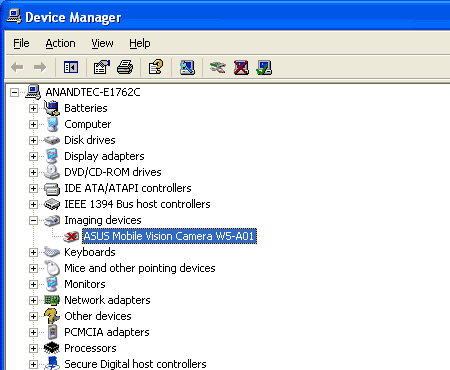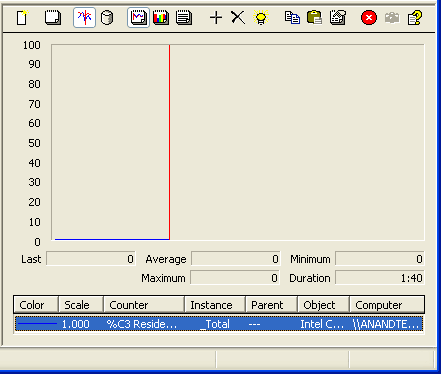Intel Core Duo USB Issue: A Mischaracterized Bug
by Anand Lal Shimpi on February 13, 2006 1:40 PM EST- Posted in
- Laptops
Problem #2 - Disabling a USB device doesn't work
If we now know that this problem should affect both Napa (Core Duo) and Sonoma (Pentium M) platforms, why is it that the results that we've seen to date don't support that theory? While we can only comment on tests that we've run ourselves, we did run into some issues with the ASUS W5F/W5A notebooks, which are quickly becoming popular Napa/Sonoma test platforms.
The reason that the two ASUS notebooks are nice to use is because they are virtually identical systems, one simply uses a Sonoma motherboard with a Pentium M CPU while the other uses a Napa board with a Core Duo CPU. In the end, it provides an excellent level playing field for comparing Core Duo to its predecessor.
With a USB 2.0 device (an external TV tuner) connected, but no driver installed, the battery life on our T60 dropped from 286 minutes down to 242, a reduction of 15.3%. Disabling the device had no effect either, as we recorded a battery life of 235 minutes. These findings are particularly important because both ASUS notebooks, the Sonoma and the Napa, feature an integrated USB 2.0 camera. Even without the drivers loaded, short of ripping the camera out of the system, these two notebooks are terrible reference points for the USB power draw issue as both of them exhibit the issue without even plugging in any external devices!
To confirm, we looked at C3 time once more on both platforms:
To further confirm, we applied the workaround documented in the Microsoft KB article. With no external devices connected to either system, their battery life jumped by approximately another hour:
While this means that our battery life tests from our Core Duo notebook article are significantly lower than they should be (we'll be providing a follow-up to that article in the near future), it also means that neither ASUS notebook should be used in pinpointing the cause or effects of this USB problem.
Adding an external USB 2.0 device to either ASUS notebook does result in an additional drop in battery life, but the initial damage is done by the integrated camera that you can't unplug. To truly isolate this problem, we'll need two notebooks that don't have any integrated USB 2.0 devices, which is why we turned to the Lenovo Thinkpad T43 and T60.
If we now know that this problem should affect both Napa (Core Duo) and Sonoma (Pentium M) platforms, why is it that the results that we've seen to date don't support that theory? While we can only comment on tests that we've run ourselves, we did run into some issues with the ASUS W5F/W5A notebooks, which are quickly becoming popular Napa/Sonoma test platforms.
The reason that the two ASUS notebooks are nice to use is because they are virtually identical systems, one simply uses a Sonoma motherboard with a Pentium M CPU while the other uses a Napa board with a Core Duo CPU. In the end, it provides an excellent level playing field for comparing Core Duo to its predecessor.

| Lenovo T60 | Nothing Connected | USB 2.0 Device Connected, No Driver Installed | USB Device Disabled |
| Reader 2002SE Battery Life in Minutes | 286 | 242 | 235 |
With a USB 2.0 device (an external TV tuner) connected, but no driver installed, the battery life on our T60 dropped from 286 minutes down to 242, a reduction of 15.3%. Disabling the device had no effect either, as we recorded a battery life of 235 minutes. These findings are particularly important because both ASUS notebooks, the Sonoma and the Napa, feature an integrated USB 2.0 camera. Even without the drivers loaded, short of ripping the camera out of the system, these two notebooks are terrible reference points for the USB power draw issue as both of them exhibit the issue without even plugging in any external devices!
To confirm, we looked at C3 time once more on both platforms:

The ASUS notebooks never enter C3 or lower power states, even with no external devices connected
To further confirm, we applied the workaround documented in the Microsoft KB article. With no external devices connected to either system, their battery life jumped by approximately another hour:
| Reader 2002SE Battery Life in Minutes | Nothing Connected | Nothing Connected (MS Fix Applied) |
| ASUS W5F (Napa/Core Duo) | 219 | 264 |
| ASUS W5A (Sonoma/Pentium M) | 204 | 273 |
While this means that our battery life tests from our Core Duo notebook article are significantly lower than they should be (we'll be providing a follow-up to that article in the near future), it also means that neither ASUS notebook should be used in pinpointing the cause or effects of this USB problem.
Adding an external USB 2.0 device to either ASUS notebook does result in an additional drop in battery life, but the initial damage is done by the integrated camera that you can't unplug. To truly isolate this problem, we'll need two notebooks that don't have any integrated USB 2.0 devices, which is why we turned to the Lenovo Thinkpad T43 and T60.










61 Comments
View All Comments
lazybum131 - Tuesday, February 14, 2006 - link
Actually, if you take into account the larger capacity battery on the T60, 56WHr compared 51 WHr, the T43 comes out ahead most of the time. The T60 has a 9.8% larger capacity battery, but with the fix it only comes out ahead 3.2%, 1.85%, 8.24% and 5.04%.Anand Lal Shimpi - Monday, February 13, 2006 - link
I'm looking into this issue myself and I will have an updated Core Duo performance article in the coming weeks that will address this as well as many other items. I wouldn't use the ASUS notebooks to compare Napa to Sonoma, especially given the internal USB 2.0 camera. I am hoping to do a Lenovo based Napa vs. Sonoma comparison that will hopefully make things a lot clearer.Take care,
Anand
JarredWalton - Monday, February 13, 2006 - link
I think that Napa allows a lower power setting, but you have to remember that two cores are still going to use more power than a single core when active. It might be interesting to see a test comparing Sonoma and Napa with the same CPU, as Dothan and Yonah both fix socket 479. There's also a question of the other peripherals, though: NIC, sound, screen, etc. all draw power. The newer Napa laptop from ASUS might have a better (re: brighter but more power hungry) LCD, for example, or a different HDD model. I don't know if they're strictly "identical" in other components, but a change of platform often involves other tweaks as well.NullSubroutine - Monday, February 13, 2006 - link
Id be more apt to say that the increase of the FSB and the second additional core are more likely the cause, because I think they did make sure the Asus laptops were exactly the same.IntelUser2000 - Tuesday, February 14, 2006 - link
Keep in mind that with laptops especially with power consumption there is so many variations to battery life problem. It could be that the implementation of the BIOS or voltage regulator is different across the two. Voltage regulator is said to be 5-10% of total power consumption, so differences in V-reg can make differences you are seeing.
Look here: http://www.hardwarezone.com/articles/view.php?id=1...">http://www.hardwarezone.com/articles/view.php?id=1...
Even with a faster CPU, MSI M635 with 1.8GHz Turion outperforms HP Compaq nx6125 with 2.0GHz Turion. It also gets better battery life even with X700.
I think 5% difference is well within the range.
huges84 - Monday, February 13, 2006 - link
Doh! I completely forgot about the dual vs single core issue. And your other points are valid as well.kmmatney - Monday, February 13, 2006 - link
Looks like I'll be using my old USB 1.1 mouse when I travel from now on.huges84 - Monday, February 13, 2006 - link
Yeah, a lot of people will be checking what version of USB their mouses are. I know I will be.Saist - Monday, February 13, 2006 - link
In reguards to THG, I was surprised to see a link as well.In reguards to AMD systems, I have a Turion on hand from Fujitsu (Lifebook S2000) and have been unable to duplicate the power loss from a default state with either a USB 2.0 external DVD drive, or a USB 2.0 Plextore ConvertX device.
I was also surprised to see that Anandtech didn't test any Turion systems themsevles in the article. But, having tested 2 Centrino systems of my own (one from Sager, the other from Dell), in addition to the Fujitsu, yes, it is time consuming.
Zebo - Monday, February 13, 2006 - link
Anand refuses to test new turions similarly equiped.. don't know why I've emailed him never heard back. Go to laptop logic.